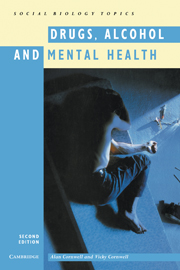Book contents
- Frontmatter
- Contents
- Preface
- 1 Drugs and drug abuse
- 2 Socially acceptable drugs
- 3 Misuse of prescribed and related drugs
- 4 Hallucinogenic drugs
- 5 Opiates and other narcotics
- 6 The biology of alcohol
- 7 The problems of alcohol use
- 8 Prevention and control of alcohol problems
- 9 Help for problem drinkers
- 10 Mental health and mental illness
- 11 Alzheimer's disease and other dementias
- 12 Other mental illnesses
- Further reading
- Index
7 - The problems of alcohol use
Published online by Cambridge University Press: 05 June 2012
- Frontmatter
- Contents
- Preface
- 1 Drugs and drug abuse
- 2 Socially acceptable drugs
- 3 Misuse of prescribed and related drugs
- 4 Hallucinogenic drugs
- 5 Opiates and other narcotics
- 6 The biology of alcohol
- 7 The problems of alcohol use
- 8 Prevention and control of alcohol problems
- 9 Help for problem drinkers
- 10 Mental health and mental illness
- 11 Alzheimer's disease and other dementias
- 12 Other mental illnesses
- Further reading
- Index
Summary
Introduction
Alcohol consumption has been present throughout history, probably since the accidental discovery of the fermentation of fruits by wild yeasts.
The use of alcohol is firmly established in society today and whilst it can, without doubt, cause problems, this is not always the case. For most people alcohol is no problem at all. Indeed, there can be beneficial effects of its use in moderation. Small amounts of alcoholic drink can aid relaxation and act as a social lubricant, facts emphasised by its widespread use. There is also some evidence that small amounts of alcohol may protect against heart disease by raising the level of the high-density lipoprotein cholesterol in the blood. However, for a significant number, alcohol can cause serious problems, both to health and to social functioning. Research has shown that there is a level of drinking which is relatively safe and this has been widely publicised in the past decade. For the purposes of this, alcohol consumption has been quantified in terms of ‘units’. One unit is defined as 8 g of alcohol, the amount in half a pint of beer or the equivalent quantity of other drinks (see section 6.1). Safe levels of drinking are usually set as up to 14 units per week for women and 21 units per week for men (see figure 7.1). For both sexes it is recommended that 2–3 days per week should be alcohol-free.
- Type
- Chapter
- Information
- Drugs, Alcohol and Mental Health , pp. 57 - 67Publisher: Cambridge University PressPrint publication year: 1993



